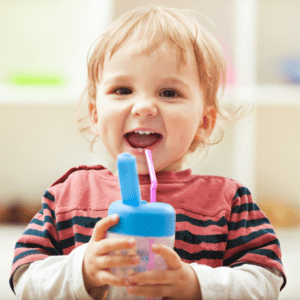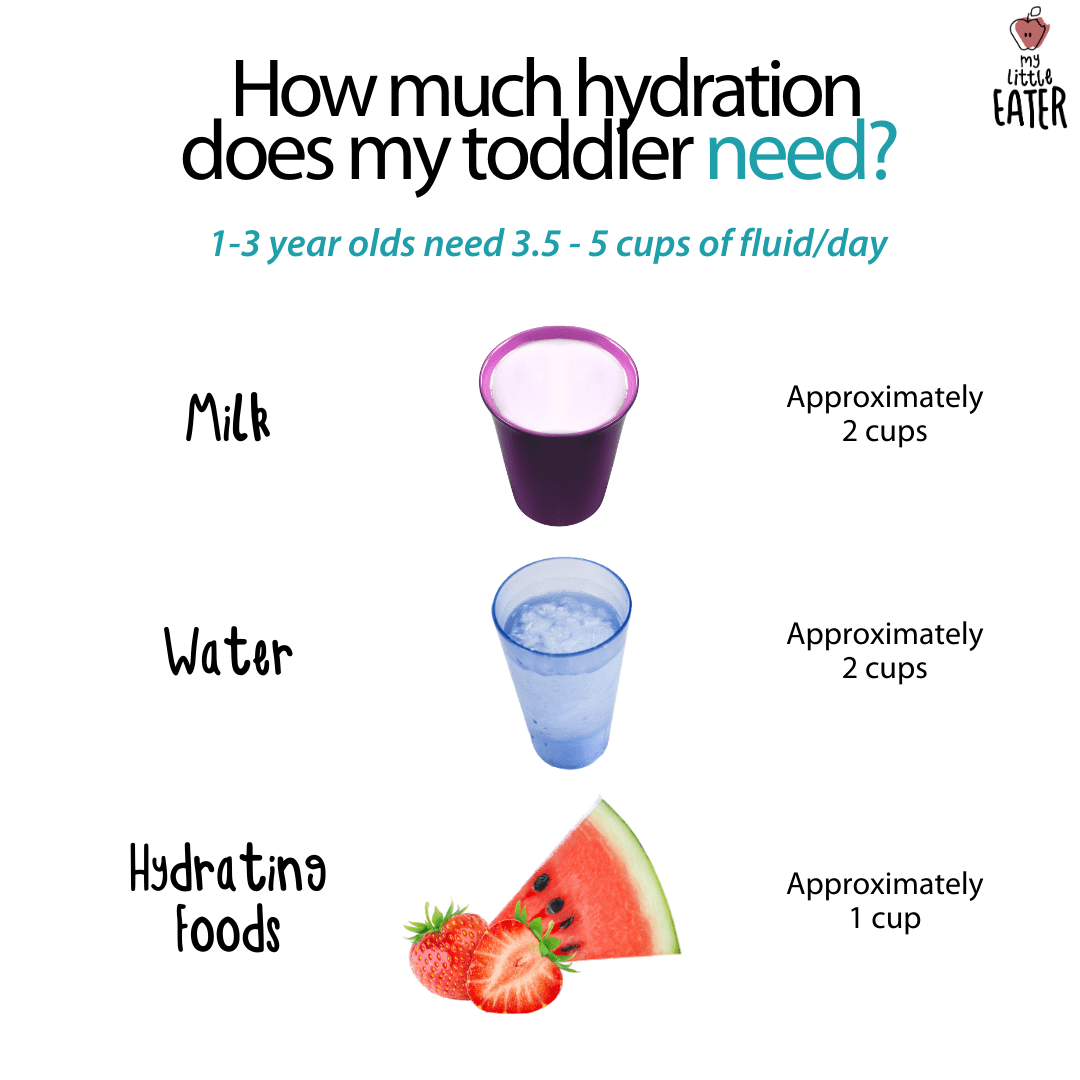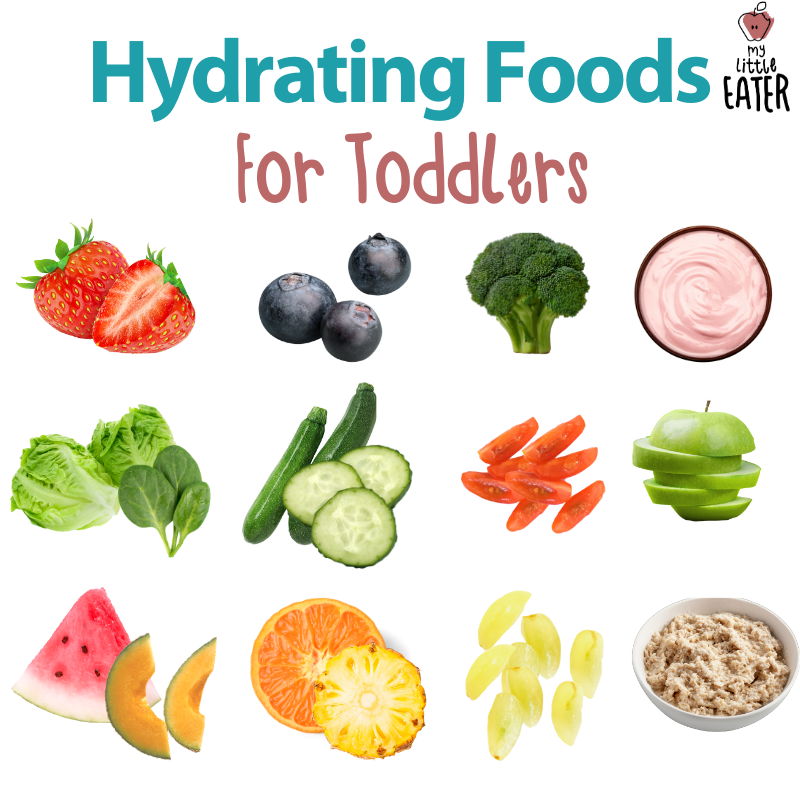
Now that summer is approaching pretty quickly, there’s no better time to learn all about hydration for your toddler.
As a parent, you know the importance of making sure your toddler has enough fluids, but sometimes it isn’t always this simple. You may always find yourself reminding them to grab a drink, which results in a fight because they don’t want to – toddlers love being defiant! Wouldn’t it just be nice if they remembered on their own to hydrate themselves without you having to nag them? Totally!
If this sounds like a preview of your day, this blog post is for you. There is no better time than now for you to learn some of my top tricks that will help eliminate the need for constant reminders, all while resulting in your toddler drinking more on their own! Let’s get started!
How much fluid should my toddler be drinking?

The current recommendation for toddlers that are 1-3 years old is 3.5-5 cups (a cup being an 8oz serving) a day. This is a general and easy to follow guideline, but since this amount can depend on their weight, age, and gender, it could vary either lower or higher.
Since this is only an average recommendation, I want you to try not to stress too much over this. Chances are, if your toddler isn’t getting enough fluid, you’ll start to pick up on signs that they aren’t. If they aren’t drinking enough you could start to notice symptoms that can be early signs of dehydration, such as:
- decreased heart rate or dizziness
- increased thirst
- strong smelling and dark yellow urine
- dry lips and skin.
Why is proper hydration so important?
Fluid plays a huge role in just about everything we got going on in our bodies – making up a pretty hefty chunk of total body weight. At birth, 75-85% of your tiny baby’s body weight would have been from fluid alone! Even now, in toddlerhood, about 65-75% of their body weight is still fluid. You can imagine that the roles it has are pretty darn important!
Making sure your toddler is drinking enough fluid can help…
- regulate body temperature
- move nutrients from their food throughout their bodies
- play a role in the digestion, absorption, and excretion of their food
- maintain electrolyte balance in the body – this helps make sure muscles and nerves function properly
- important part of blood composition and helps to transport oxygen throughout the body
- prevent constipation – keeps things moving!
The ultimate goal in ensuring proper hydration is to prevent dehydration. If you’re noticing any of the symptoms associated with dehydration I mentioned above, you will want to dig deeper and determine how much fluid they are getting, from what sources (I cover this in more detail below), and if adjustments need to be made to help you solve these problems!
Help! Water, juice, milk, food? Which provides the most hydration?
Although milk, water, juice, and foods can all contribute to fluid intake, there are definitely benefits to some, and not so much others. When you break it down, the best source of hydration is something that focuses solely on this purpose (hint: water), with no extra calories, sugar, or fat that could reduce the amount of fluid in the food product (like milk, juice, or food). I often refer to beverages that provide calories or other nutrients, in my Feeding Toddlers online course, as a food source because it is providing nourishment like solid foods do.
Water
Water wins the gold metal for the best source of hydration, and for a true thirst quencher, this is the beverage I recommend. Water can be served with meals if you choose, or without, and should always be the sole beverage chosen between meals so that they don’t fill up on unnecessary calories too close to a meal.
Milk
Milk is an important diet staple for toddlers, and should always be included in their diet, unless there is a specific reason, like an allergy for example. Full fat, unsweetened milk is a more nutrient dense beverage – healthy fats, vitamin D, and calcium help support proper nutrition. Because milk tends to be more nutrient dense, it does have a lower overall fluid content. Full fat specifically will have less fluid amounts than 1% or 2%, and since full fat is recommended up until at least the age of 2, toddlers who do drink full fat milk will get less hydration from this, compared to older children who can drink lower fat milk sources.
The current recommendation for milk intake for toddlers is no more than 16oz a day or 2 cups. This is because if you offer more to your toddler they will likely start to eat less solid foods since it is so nutrient dense. And even though it is a great beverage option, there can always be too much of a good thing. Try to remind your toddler that milk is a food instead of a drink and that it will only be served with meals or snacks.
Breastmilk
Breastmilk is also a source of hydration, and if you choose to breastfeed your toddler, instead of offering cow’s milk, they will still be getting a good portion of their daily fluid from it regardless. Breastmilk is packed with vitamins and nutrients, is a great source of protein, and has immune fighting properties too! But, since it’s nutrient dense, it should also be considered a food just like milk is.
If you are breastfeeding, you can replace the 16oz recommendation of cows milk with four breastfeeding sessions instead. Once you begin feeding more solid foods, breastmilk doesn’t need to provide as much nourishment as it would have when they were younger than 1 year old. You may need to start a breastfeeding schedule so that it is offered with snacks, or after solid food, instead of in-between. This way they still associate water with being a drink, and breastmilk with being a food.
Juice
Juice does provide fluid in your toddler’s diet, but not the full thirst quenching hydration you’re looking for on a hot summer’s day! Juice, like milk, has calories, added sugar, and really not a lot of nutrients besides Vitamin C, which is easy to get, usually, through other foods in the diet.
Current recommendations for juice is to limit it to only 4oz daily or half a cup. But ideally? None. This way, you avoid them filling up on it and replacing solid foods, since there really is no benefit to including it in their diet. If you are serving small amounts of juice, again, think of it as a food and serve it only with meals and snacks, instead of in-between.
Foods
Another way to make sure your toddler stays hydrated is offering foods with a high water content! There are lots of healthy veggie and fruit options that have pretty high water content and can help contribute to making sure they stay properly hydrated. Fruits like watermelon, cantaloupe, strawberries, tomatoes, oranges, grapes, apples, and blueberries are just some examples. Cucumbers, celery, spinach, and broccoli/cauliflower are also some of the popular veggies that can help them to stay hydrated. Foods like yogurt, cheese, and even cooked cereals like oatmeal, can also help too!

Since there are different sources of hydration in the typical toddler diet, it can be confusing to know if you are helping them meet their needs. To help clarify things, here’s an example of how various dietary sources could be helping them do so. Say your toddler is drinking the recommended 16oz of milk per day – they would get roughly 2 cups from that, another 2 cups from water, and then approximately 1 cup from their food, depending on their diet. This could vary from toddler to toddler and should only be used as an example. Remember everyone is different. If you are seeing signs of good hydration, like clear/pale yellow urine and your toddler is thriving, rest assured they are meeting their needs one way or another!
Okay, water is best. Tell me how I convince them to drink it!!
I often hear “Yes Edwena, I know water is best, but seriously, how can I get my toddler to Just. Drink. The. Water?!” My answer to this is, make it fun! Think of the things that might entice your toddler to drink water, and you’d be surprised that some of the things you come up with are so simple and easy, you wonder why you didn’t think of them before.
Tip #1 – Pick a fun water bottle!
Better yet, let them pick (if they’re able to of course)! This can be fun for them and gives them a little independence too. Let’s give a big high five to all those water bottle companies that make water bottles with Paw Patrol and Peppa Pig – they knew what you needed before you did!
Tip #2 – Prompt your toddler to drink from a water bottle every half hour
Put that fun water bottle to good use and keep it full with cool, fresh water all day long. If your toddler has access to it, and knows milk or juice is off the table between meals and snacks, they’ll be more likely to quench their thirst with water instead. Likely though, they’ll need some prompting so I recommend setting a timer, and every time it goes off, say “It’s time for a water break!”. Make it fun and exciting and even turn it into a game! Who can be the first to race to find their water bottle and take a sip? Maybe declare how hard you’ve worked and brag about how much you deserve this sip of water. Appeal to your toddler’s sense of humour and pride and keep promoting them frequently between meals/snacks.
Tip #3 – Add in novelty with ice cubes and straws!
Adding ice cubes to their water can be fun for them because it’s something new and different, and in all fairness, the funny noises they make hitting the side of the cup can make all the difference. You can make this even more fun and bring novelty into it by making them their own special ice cubes using different ice cube molds, which you can find on Amazon or Ikea!
Did you ever use one of those cool bendy, swirly straws as a kid? What toddler wouldn’t love them! If your toddler has started drinking from an open cup, but is still struggling with drinking enough water throughout the day, try adding a cool straw into the mix. Amazon again is a great resource for these, and just like letting them pick out a cup, you could let them pick out the straw too.
Tip #4- The rubber band trick
One game that helps them work towards the goal of drinking a certain amount of water per day is to challenge them to do so by turning it into a game. A simple yet productive way to do this is to put a rubber band on their water bottle to signify where you’d like them to drink to. This can be fun for them to prove to you that they can do it, all while still being a measurable way for you to know exactly how much water they’re drinking.
Tip #5 – Add fresh fruit flavouring
If your toddler is really struggling with drinking water, try adding some frozen or fresh fruit or veggies. This can add a slight flavouring to their water and entice them to drink it, without the added sugar that juice would have. Some good choices include berries, oranges, lemons, or cucumbers, but feel free to add one your toddler really enjoys.
Tip #6 – Be a role model
Finally, work your magic and model water drinking! Use exaggerated sounds that make it sound so good and refreshing that they’ll really want to try! You could make “ahhh” sounds after you have a drink, and watch just how quickly they want to try too.
And there you have it! Simple, easy, and doable tips I know will get your toddler on the right path to proper hydration, so you can stop worrying, and spend more time enjoying fun outdoor activities in the sun.
Are you struggling with other areas of your toddlers diet? Need some help knowing what and when to feed them? Want some guidance on how to create healthy eating or drinking behaviours? Check out my Feeding Toddlers online course! In this course, I start with basic principles like proper seating and setting up a positive mealtime environment, right down to serving sizes and foods to include in your toddler’s diet. I give you the confidence to know exactly how to handle those “What should I do when?” situations.
Some of the links on this page are affiliate links. That means, I get a small commission if you purchase through this link. However, I make it a point to only share tools and resources I truly love and use.





